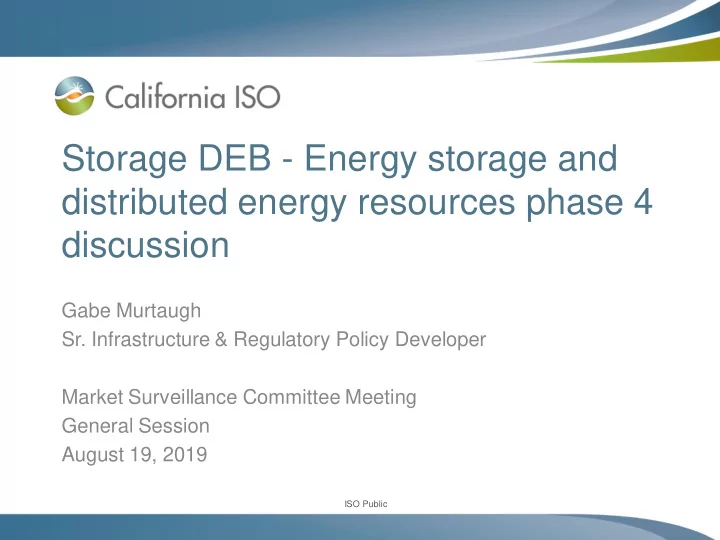

Storage DEB - Energy storage and distributed energy resources phase 4 discussion Gabe Murtaugh Sr. Infrastructure & Regulatory Policy Developer Market Surveillance Committee Meeting General Session August 19, 2019 ISO Public ISO Public
Agenda • Background • Storage resource costs • Modelling constraints • Proposed formulations for modelling cycle depth costs – Multiplier attached to SOC – Multiplier attached to the change in SOC Slide 2 ISO Public
The ISO is proposing a methodology to calculate variable costs for storage resources in ESDER 4 • The ISO currently does not calculate default energy bids for storage resources • There is a considerable amount of storage – particularly lithium-ion – in the new generation queue • Storage is often suggested as a solution for local issues to mitigate the retirement of essential reliability resources • Planning models used by the CPUC and the ISO tend to include 4- hour storage ‘moving’ generation from peak solar hours to peak net load hours – Generally the existing battery fleet is not doing this Page 3 ISO Public
Batteries might be used to ‘shift’ energy from one time of the day to another Page 4 ISO Public
The ISO identified four primary cost categories for storage resources • Energy – Energy likely procured through the energy market • Losses – Round trip efficiency losses – Parasitic losses • Cycling costs – Battery cells degrade with each “cycle” they run – Cells may degrade faster with “deeper” cycles – Cycling costs should be included in the DEBs, as they are directly related to storage resource operation – It is expensive for these resources to capture current spreads • Opportunity costs Page 5 ISO Public
Estimated Costs for one discharge period with $300,000 replacement cost and 95% efficiency $175.00 $150.00 $125.00 $100.00 $75.00 $50.00 $25.00 $- 0% 10% 20% 30% 40% 50% 60% 70% 80% 90% 100% Cycle Depth Page 6 ISO Public
Costs can be demonstrated in a relatively simple manner with respect to cycle depth 𝑈𝑝𝑢𝑏𝑚 𝐷𝑝𝑡𝑢 𝑔𝑝𝑠 𝐸𝑗𝑡𝑑ℎ𝑏𝑠𝑓 = 𝐷𝑧𝑑𝑚𝑓 𝐸𝑓𝑞𝑢ℎ 2 𝑁𝑏𝑠𝑗𝑜𝑏𝑚 𝐷𝑝𝑡𝑢 𝑔𝑝𝑠 𝐸𝑗𝑡𝑑ℎ𝑏𝑠𝑓 = 2 ∗ 𝐷𝑧𝑑𝑚𝑓 𝐸𝑓𝑞𝑢ℎ where Cycle Depth is a value between 0 and 1 Cycle Depth Marginal Total Cost (%) Cost 1 0.10 0.2 20 40 4 160 8 40 60 360 12 70 490 14 Page 7 ISO Public
The ISO has two potential ideas for modelling these costs using existing software • Model energy with the state of charge 𝐷𝐸 𝑗,𝑢 = 𝑤 𝑗,𝑢 𝜍 𝑗 𝑁𝑏𝑦 𝑇𝑃𝐷 − 𝑇𝑃𝐷 𝑗,𝑢 where: i : resource t : interval v : 1 when the state of charge is decreasing 𝜍 : constant Max SOC: Maximum SOC available for dispatch SOC : state of charge Assume a +/-24 MW storage resource with 100 MWh of capacity and 𝜍 = 20. Resource is forbidden to operate above 80 MWh or below 10 MWh (Max discharge = 70%). Page 8 ISO Public
Proposed DEBs reflecting marginal costs of cycle depths 80% T+1 12 MW $0.20 (1% CD) State of Charge 24 MW $0.40 (2% CD) 20% T+x 12 MW $12.20 (61% CD) 24 MW $12.40 (62% CD) Page 9 ISO Public
There are several pros and cons to modelling resources based on total costs for cycle depth Pros • This model will always be greater than or equal to the cost to operate the battery – Aligns with increasing marginal costs • Price for any discharge increases as state of charge decreases – Market outcomes will tend to charge the battery Cons • The model may grossly overestimate the cost to produce – This happens if the resource charges “mid - discharge” Page 10 ISO Public
A second option for modeling costs includes the change in SOC from the dispatch • Model energy with the state of charge 𝐷𝐸 𝑗,𝑢 = 𝑣 𝑗,𝑢 𝜍 𝑗 𝑇𝑃𝐷 𝑗,𝑢−1 − 𝑇𝑃𝐷 𝑗,𝑢 𝑄 𝑗,𝑢−1 + 𝑄 𝑗,𝑢 Δ𝑈 = 𝑣 𝑗,𝑢 𝜍 𝑗 2 𝑈 Assume a +/-24 MW storage resource with 100 MWh of capacity and 𝜍 = 7 Page 11 ISO Public
Proposed DEBs reflecting total costs 80% T+1 12 MW $7 (1% CD) State of Charge 24 MW $14 (2% CD) 20% T+x 12 MW $7 (61% CD) 24 MW $14 (62% CD) Page 12 ISO Public
There are several pros and cons to modelling resources based on total costs for cycle depth Pros • May more efficiently dispatch resources for energy (MWh) • May more consistently produce the correct price on average Cons – Overestimates costs for large dispatches when cycle depth is thin and under estimates costs for small dispatches when cycle depth is deep Page 13 ISO Public
Recommend
More recommend